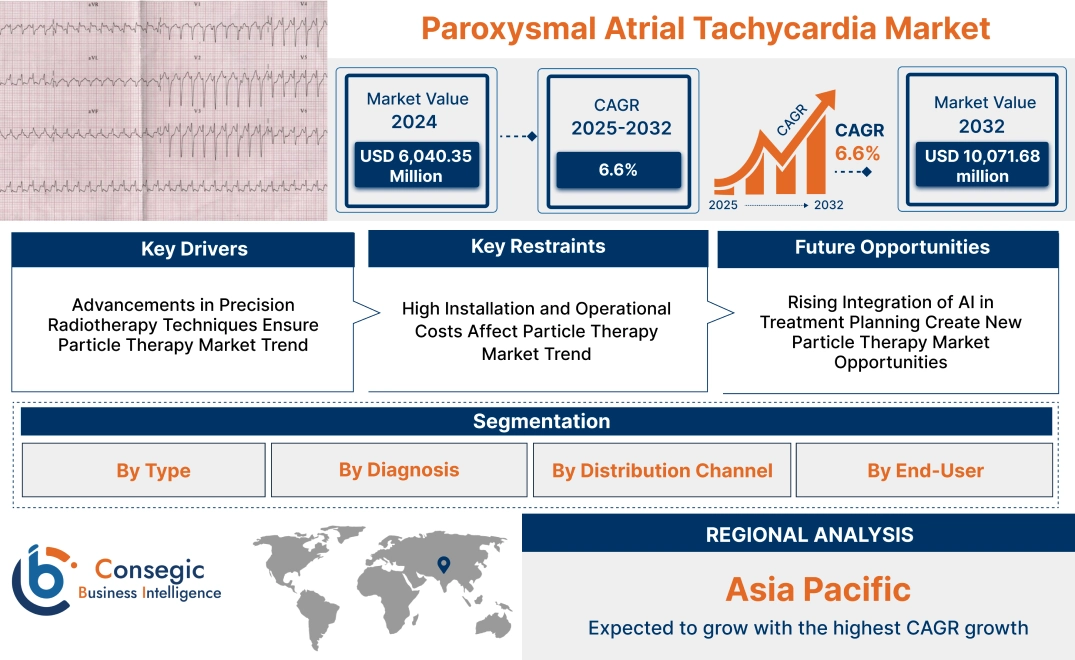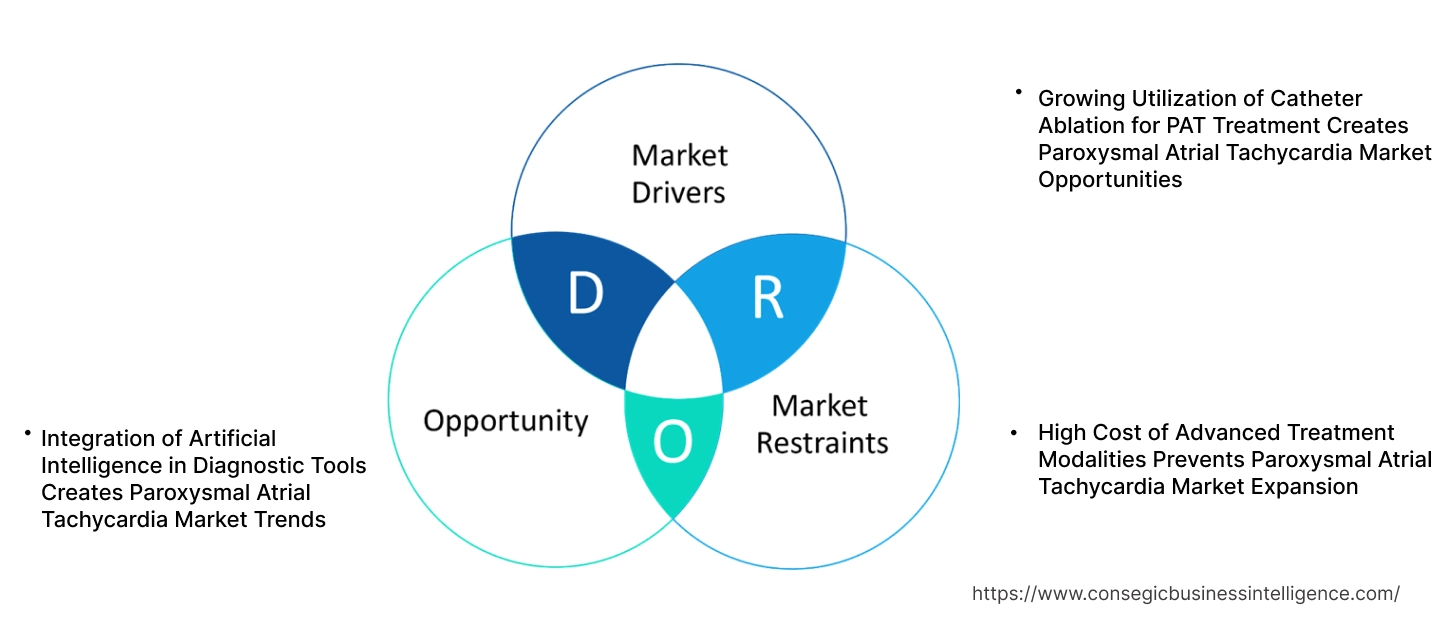Paroxysmal Atrial Tachycardia Market Size:
Paroxysmal Atrial Tachycardia Market size is estimated to reach over USD 10,071.68 Million by 2032 from a value of USD 6,040.35 Million in 2024 and is projected to grow by USD 6,331.38 Million in 2025, growing at a CAGR of 6.6 % from 2025 to 2032.
Paroxysmal Atrial Tachycardia Market Scope & Overview:
Paroxysmal atrial tachycardia (PAT) is a type of arrhythmia characterized by sudden episodes of rapid heartbeats originating in the atria. It is typically triggered by electrical signal abnormalities within the heart. Key products in the market include diagnostic devices, pharmacological therapies, catheter ablation systems, and wearable monitoring devices. These solutions facilitate accurate detection, effective treatment, and long-term management of the condition.
The benefits encompass enhanced symptom control, reduced recurrence of episodes, and improved patient quality of life. Advanced treatment options ensure precise interventions and support personalized patient care. Applications include diagnosis, patient monitoring, and therapeutic intervention. End-use industries include hospitals, ambulatory surgical centers, cardiology clinics, and research institutions specializing in cardiac health and treatment innovations.
Key Drivers:
Growing Utilization of Catheter Ablation for PAT Treatment Creates Paroxysmal Atrial Tachycardia Market Opportunities
Catheter ablation has emerged as a prominent treatment for paroxysmal atrial tachycardia, offering precision and effectiveness. The procedure involves the targeted delivery of energy to disrupt the electrical pathways causing arrhythmia. This minimally invasive intervention reduces the recurrence of PAT episodes and enhances patient outcomes. For instance, advancements in catheter ablation technology, such as radiofrequency and cryoablation, have demonstrated significant efficacy in controlling arrhythmic episodes.
The increasing preference for catheter ablation over pharmacological treatments due to its long-term effectiveness and lower side effects is boosting its adoption. This trend is anticipated to significantly contribute to the paroxysmal atrial tachycardia market demand.
Key Restraints:
High Cost of Advanced Treatment Modalities Prevents Paroxysmal Atrial Tachycardia Market Expansion
The cost associated with advanced treatments, including catheter ablation and wearable cardiac devices, remains a significant barrier to paroxysmal atrial tachycardia market expansion. These interventions often require substantial investment in terms of technology, skilled professionals, and post-procedural care. For instance, the average cost of a catheter ablation procedure in the United States ranges between $20,000 and $50,000.
This financial burden limits access for patients in low- and middle-income regions and poses challenges for healthcare providers in offering cost-effective solutions. Consequently, the high cost of these interventions continues to obstruct the widespread adoption of advanced PAT treatments, restraining paroxysmal atrial tachycardia market trend.
Future Opportunities :
Integration of Artificial Intelligence in Diagnostic Tools Creates Paroxysmal Atrial Tachycardia Market Trends
Artificial intelligence (AI) integration in diagnostic tools is poised to revolutionize the detection and management of paroxysmal atrial tachycardia. AI algorithms are being developed to analyze electrocardiogram (ECG) data with greater accuracy and speed, enabling early diagnosis and personalized treatment strategies. For instance, AI-driven wearable devices and mobile applications are under development to monitor heart rhythm continuously, identifying arrhythmias in real-time.
As these technologies mature, they are expected to enhance diagnostic precision, reduce misdiagnoses, and facilitate timely interventions. This presents a substantial paroxysmal atrial tachycardia market opportunity, fostering innovation and adoption in the near future.
Paroxysmal Atrial Tachycardia Market Segmental Analysis :
By Type:
Based on type, the market is segmented into Atrioventricular Nodal Reentrant Tachycardia (AVNRT), Atrioventricular Reentrant Tachycardia (AVRT), and Ectopic Atrial Tachycardia.
The Atrioventricular Nodal Reentrant Tachycardia (AVNRT) segment accounted for the largest revenue in Paroxysmal Atrial Tachycardia Market share in 2024.
- AVNRT is the most commonly diagnosed form of supraventricular tachycardia.
- It is characterized by a fast heart rhythm originating from the atrioventricular node.
- Diagnostic advancements, including electrocardiograms and electrophysiological studies, have enhanced its identification.
- Treatment options such as catheter ablation and antiarrhythmic medications have seen significant adoption in hospitals and specialty cardiology clinics.
- AVNRT is often diagnosed in patients who experience palpitations, dizziness, or syncope.
- The increasing incidence of lifestyle diseases, such as hypertension, is contributing to higher rates of AVNRT diagnosis.
- Patients with AVNRT often undergo follow-up care after ablation procedures to monitor for recurrence.
- Long-term management options focus on reducing symptoms and preventing recurrence of tachycardia episodes.
- Therefore, according to paroxysmal atrial tachycardia market analysis, the dominance of AVNRT in terms of revenue is attributed to its prevalence and the availability of targeted diagnostic and therapeutic solutions.
The Ectopic Atrial Tachycardia segment is anticipated to register the fastest CAGR during the forecast period.
- Ectopic atrial tachycardia occurs due to abnormal electrical signals in the atria.
- Innovations in mapping techniques and ablation procedures have improved treatment outcomes.
- Rising awareness and diagnostic capabilities, especially in pediatric populations, are driving this segment.
- This form of tachycardia is often harder to diagnose than AVNRT due to its irregular onset and presentation.
- New ablation techniques, such as radiofrequency ablation and cryoablation, are showing promise in improving patient outcomes.
- Increased adoption of wearable devices for continuous monitoring of heart rhythms is aiding early detection.
- The rise in cases among children and young adults is contributing to growing trend for treatment solutions.
- Multidisciplinary care teams, including pediatric cardiologists, are becoming more involved in the management of ectopic atrial tachycardia.
- Thus, according to paroxysmal atrial tachycardia market analysis, the projected growth of Ectopic Atrial Tachycardia is fueled by advancements in detection techniques and a growing focus on pediatric cardiology.
By Diagnosis:
Based on diagnosis, the market is segmented into Electrocardiogram (ECG), Holter Monitoring, Event Monitoring, and Others.
The Electrocardiogram (ECG) segment accounted for the largest revenue in Paroxysmal Atrial Tachycardia Market share in 2024.
- ECG remains the gold standard for initial diagnosis of paroxysmal atrial tachycardia.
- It is widely used due to its non-invasive nature and ability to provide immediate results.
- Technological advancements, including portable and wearable ECG devices, have expanded its adoption.
- In addition to traditional ECG, modern devices also allow for remote transmission of results, aiding in quicker diagnosis.
- The growing use of smartphone-based ECG applications is broadening the accessibility of diagnostic tools.
- ECGs are often the first line of assessment in emergency settings and outpatient visits.
- With an increasing geriatric population, the trend for ECG services is rising as older individuals are at a higher risk of arrhythmias.
- ECG screenings are becoming more common as part of routine health check-ups for early detection.
- Therefore, according to market analysis, the significant revenue share of the ECG segment is supported by its accessibility, reliability, and integration into routine clinical practice.
The Holter Monitoring segment is anticipated to register the fastest CAGR during the forecast period.
- Holter monitoring offers continuous recording of heart rhythms over 24–48 hours.
- It is increasingly adopted for detecting intermittent episodes of paroxysmal atrial tachycardia that are missed during standard ECG tests.
- Technological improvements in compactness and battery life of Holter devices are contributing to their rising trend.
- The ability to monitor patients over extended periods increases the likelihood of detecting rare and infrequent tachycardia episodes.
- Remote monitoring solutions have contributed to the growing use of Holter monitoring, allowing healthcare providers to track patient conditions in real-time.
- Holter monitoring is often recommended for patients who have unclear or undiagnosed symptoms.
- The rise in outpatient monitoring and home-based healthcare solutions is promoting the adoption of Holter devices.
- Insurance coverage for ambulatory monitoring services is improving, facilitating greater access to Holter monitoring for patients.
- Thus, according to market analysis, the growing demand for prolonged monitoring solutions and advancements in wearable technology are accelerating the adoption of Holter monitoring.
By Distribution Channel:
Based on distribution channel, the market is segmented into Hospital Pharmacies, Retail Pharmacies, and Online Pharmacies.
The Hospital Pharmacies segment accounted for the largest revenue of 43.20% share in 2024.
- Hospital pharmacies supply medications required for immediate and post-procedure care.
- These pharmacies ensure seamless access to antiarrhythmic drugs and other supportive medications.
- Their integration with hospital operations enables quick fulfillment of prescriptions.
- Hospital pharmacies have direct access to patient medical records, ensuring personalized medication management.
- The close proximity to healthcare providers allows for better coordination in the event of medication changes or complications.
- Hospitals often stock a wider range of arrhythmia medications due to the high volume of patients requiring specialized care.
- Hospital pharmacies also play a vital role in providing patient education on medication adherence.
- They are increasingly adopting automated medication dispensing systems to improve efficiency and reduce errors.
- Therefore, according to market analysis, the integration of hospital pharmacies into patient care pathways ensures their substantial contribution to market revenue.
The Online Pharmacies segment is anticipated to register the fastest CAGR during the forecast period.
- Online platforms offer convenience, home delivery, and competitive pricing for prescription drugs.
- Rising internet penetration and consumer preference for online purchasing contribute to this growth.
- The availability of telemedicine services further supports online pharmacy adoption.
- Online pharmacies provide access to medications that may not be available locally, particularly in rural or remote areas.
- The growing trend of home healthcare services is driving paroxysmal atrial tachycardia market demand for online pharmacies to deliver medications directly to patients.
- Subscription models for chronic disease management are gaining traction, allowing for ongoing delivery of arrhythmia medications.
- Digital tools integrated with online pharmacies allow patients to track their medication schedules and interact with healthcare providers.
- Increasing regulatory acceptance and improved online prescription fulfillment systems are contributing to this trend.
- Thus, according to market analysis, consumer inclination towards convenient, cost-effective, and accessible pharmaceutical solutions is driving the rapid growth of online pharmacies.
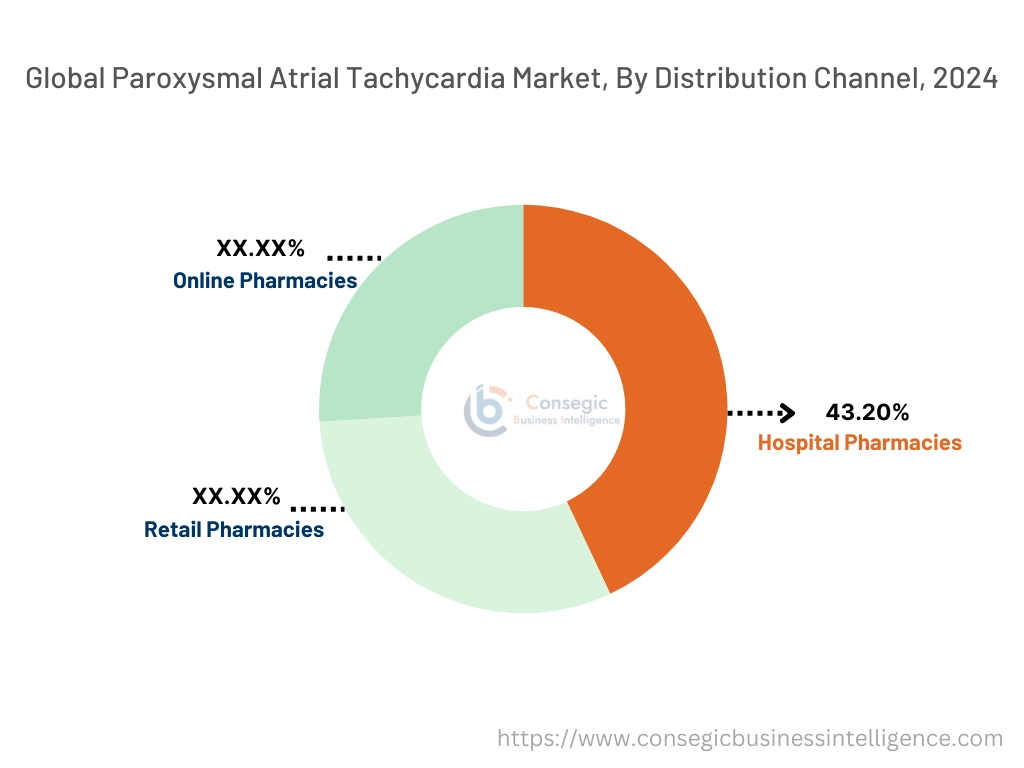
By End-User:
Based on end-users, the market is segmented into Hospitals, Specialty Cardiology Clinics, and Ambulatory Surgical Centers.
The Hospitals segment accounted for the largest revenue share in 2024.
- Hospitals are equipped with comprehensive diagnostic and therapeutic facilities for managing paroxysmal atrial tachycardia.
- Availability of advanced technologies and skilled professionals ensures effective treatment.
- Hospitals are also the primary centers for emergency care, where many cases of tachycardia are initially addressed.
- They offer access to a wide range of treatment options, including catheter ablation and pharmacological therapies.
- Hospitals are central to ongoing clinical trials that test new therapies and devices for arrhythmia management.
- Larger hospital networks often collaborate with specialized cardiology departments to improve care quality.
- Emergency departments in hospitals are frequently the first to diagnose and treat acute episodes of paroxysmal atrial tachycardia.
- The availability of intensive care units for post-procedure recovery further solidifies the hospital's role in treatment.
- Therefore, according to market analysis, the extensive resources and infrastructure of hospitals contribute to their dominance in the paroxysmal atrial tachycardia market.
The Specialty Cardiology Clinics segment is anticipated to register the fastest CAGR during the forecast period.
- These clinics offer focused and personalized care for patients with cardiac arrhythmias.
- Increasing patient preference for specialized treatment and shorter waiting times drive the demand for cardiology clinics.
- Clinics often adopt advanced diagnostic tools and minimally invasive treatment options, enhancing their appeal.
- Many clinics offer a holistic approach, integrating lifestyle counseling with medical treatment.
- The growth of outpatient procedures, such as catheter ablation, is driving more patients to seek treatment in specialized clinics.
- Telecardiology services are becoming more prevalent in these clinics, allowing remote consultations and follow-up care.
- The rising cost of healthcare is encouraging patients to seek alternative care settings, including cardiology clinics, which often offer more affordable options.
- Specialized cardiology clinics are becoming more equipped with advanced electrophysiological mapping systems for arrhythmia diagnosis and treatment.
- Thus, according to market analysis, the rise in patient preference for specialized care and advancements in clinic-based technologies are propelling the growth of cardiology clinics.
Regional Analysis:
The regional segment includes North America, Europe, Asia Pacific, Middle East and Africa, and Latin America.
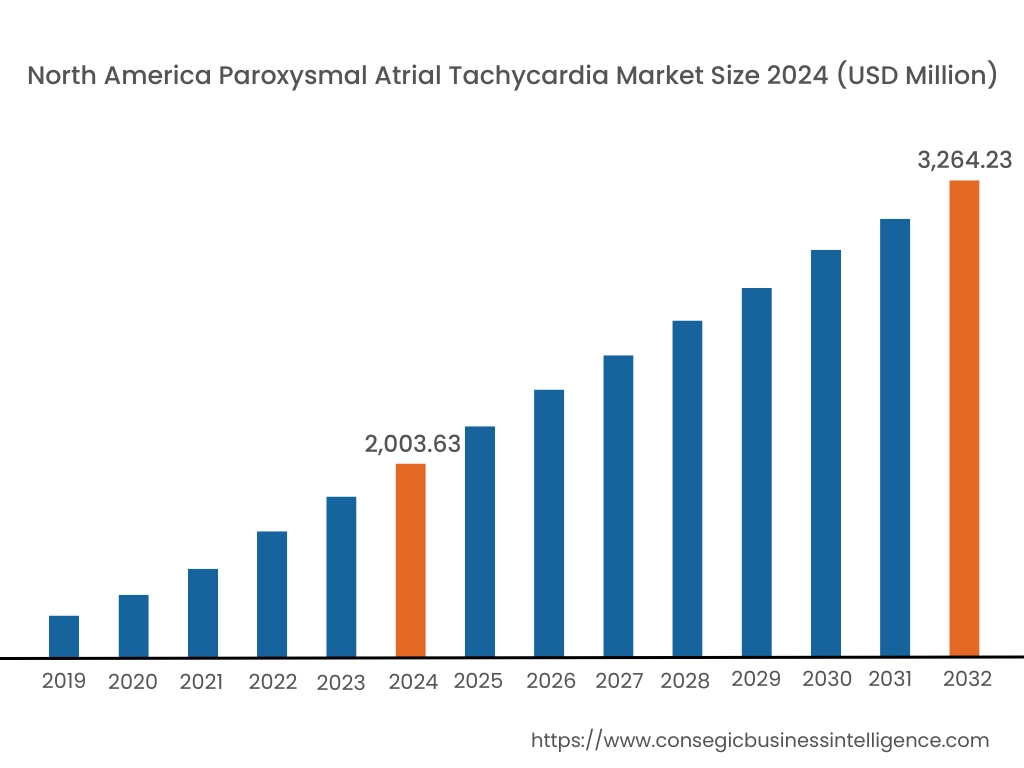
In 2024, North America was valued at USD 2,003.63 Million and is expected to reach USD 3,264.23 Million in 2032. In North America, the U.S. accounted for the highest share of 72.10 % during the base year of 2024. North America holds a dominant position in the paroxysmal atrial tachycardia (PAT) market due to advanced healthcare infrastructure and increased awareness of cardiovascular diseases. The United States leads the market, with high adoption of diagnostic tools and treatment options. The region benefits from the presence of leading pharmaceutical companies and well-established healthcare systems, which facilitate the availability of PAT treatments. Moreover, ongoing clinical research and innovations in electrophysiology contribute to the region's paroxysmal atrial tachycardia market growth. Government healthcare programs, including insurance coverage for cardiovascular treatments, also support market accessibility.
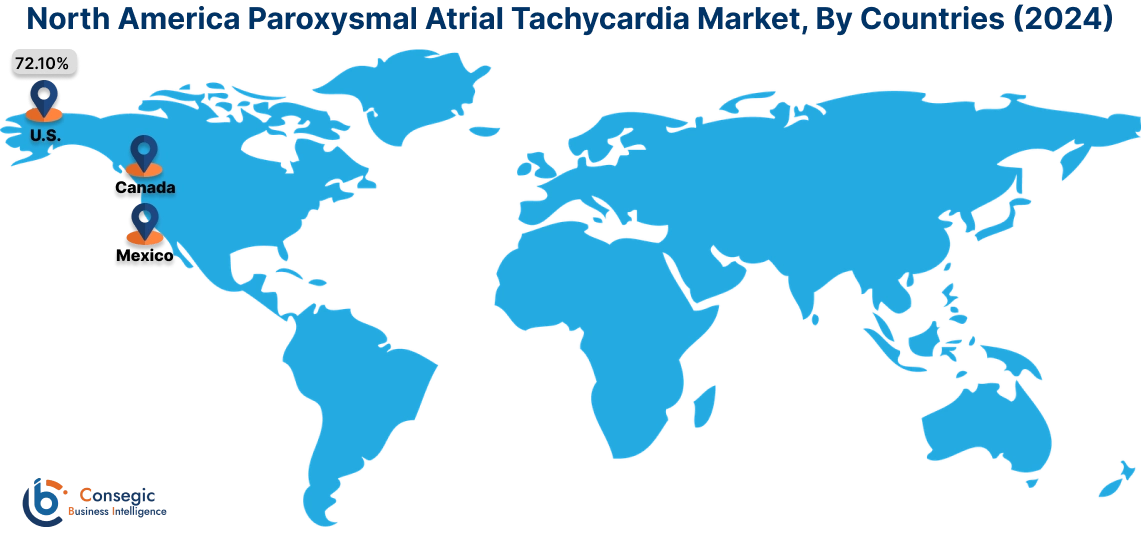
In Asia Pacific, the market is experiencing the fastest growth with a CAGR of 7.0% over the forecast period. Asia-Pacific exhibits significant potential in the PAT market, with countries like Japan, China, and India driving regional demand. Japan’s advanced healthcare system and high prevalence of cardiovascular diseases support strong market performance. In China and India, the market faces challenges such as limited access to specialized care and diagnostic tools. However, rising awareness of atrial arrhythmias, increasing healthcare investments, and a growing elderly population contribute to steady market expansion. Additionally, improved healthcare policies and greater access to treatments in urban areas are expected to propel growth in the coming years.
Europe is a key market for paroxysmal atrial tachycardia treatments, with countries like Germany, the UK, and France showing strong demand for diagnostics and therapies. The European healthcare system supports the widespread use of advanced electrophysiology treatments and catheter ablation techniques for managing PAT. Government initiatives and funding for cardiovascular disease research enhance market access. The presence of leading medical device manufacturers and pharmaceutical companies in the region further contributes to market expansion. However, healthcare access disparities between Western and Eastern Europe may affect growth potential in certain areas.
The Middle East and Africa market for paroxysmal atrial tachycardia remains in the early stages of development. The Middle East region, particularly the UAE and Saudi Arabia, benefits from improved healthcare infrastructure and growing awareness of cardiovascular diseases. However, challenges persist in Africa, where limited access to healthcare services, especially in rural areas, affects the market’s reach. Economic disparities, insufficient diagnostic facilities, and lack of specialized treatment options slow the market’s expansion. Nevertheless, international collaborations and government investments in healthcare are likely to boost the availability of PAT treatments in the region.
Latin America presents moderate market potential for paroxysmal atrial tachycardia, with Brazil and Mexico being the primary contributors. While awareness of cardiovascular diseases has improved, the region faces challenges in terms of healthcare infrastructure, particularly in rural areas. The availability of advanced diagnostic tools and treatment options remains limited in certain countries, hindering paroxysmal atrial tachycardia market growth. However, government initiatives aimed at expanding healthcare access and the increasing prevalence of cardiovascular diseases are expected to support steady market progress. Additionally, rising healthcare investments and regional partnerships with international companies could enhance treatment availability.
Top Key Players and Market Share Insights:
The Global Paroxysmal Atrial Tachycardia Market is highly competitive with major players providing FWA to the national and international markets. Key players are adopting several strategies in research and development (R&D), product innovation, and end-user launches to hold a strong position in the Global Paroxysmal Atrial Tachycardia Market. Key players in the Paroxysmal Atrial Tachycardia industry include-
- Bristol-Myers Squibb (United States)
- AbbVie Inc. (United States)
- Abbott Laboratories (United States)
- Hansen Medical (United States)
- AtriCure, Inc. (United States)
- Sanofi S.A. (France)
- Johnson & Johnson (United States)
- Medtronic PLC (Ireland)
- Boston Scientific Corporation (United States)
- Philips Healthcare (Netherlands)
Paroxysmal Atrial Tachycardia Market Report Insights :
| Report Attributes | Report Details |
| Study Timeline | 2019-2032 |
| Market Size in 2032 | USD 10,071.68 Million |
| CAGR (2025-2032) | 6.6% |
| By Type |
|
| By Diagnosis |
|
| By Distribution Channel |
|
| By End-User |
|
| By Region |
|
| Key Players |
|
| North America | U.S. Canada Mexico |
| Europe | U.K. Germany France Spain Italy Russia Benelux Rest of Europe |
| APAC | China South Korea Japan India Australia ASEAN Rest of Asia-Pacific |
| Middle East and Africa | GCC Turkey South Africa Rest of MEA |
| LATAM | Brazil Argentina Chile Rest of LATAM |
| Report Coverage |
|
Key Questions Answered in the Report
How big is the Paroxysmal Atrial Tachycardia Market? +
In 2024, the Paroxysmal Atrial Tachycardia Market was USD 6,040.35 million.
What will be the potential market valuation for the Paroxysmal Atrial Tachycardia Market by 2032? +
In 2032, the market size of Paroxysmal Atrial Tachycardia Market is expected to reach USD 10,071.68 million.
What are the segments covered in the Paroxysmal Atrial Tachycardia Market report? +
The diagnosis and end-user industry are the segments covered in this report.
Who are the major players in the Paroxysmal Atrial Tachycardia Market? +
Bristol-Myers Squibb (United States), AbbVie Inc. (United States), Sanofi S.A. (France), Johnson & Johnson (United States), Medtronic PLC (Ireland), Boston Scientific Corporation (United States), Philips Healthcare (Netherlands), Abbott Laboratories (United States), Hansen Medical (United States), AtriCure, Inc. (United States) are the major players in the Paroxysmal Atrial Tachycardia market.
